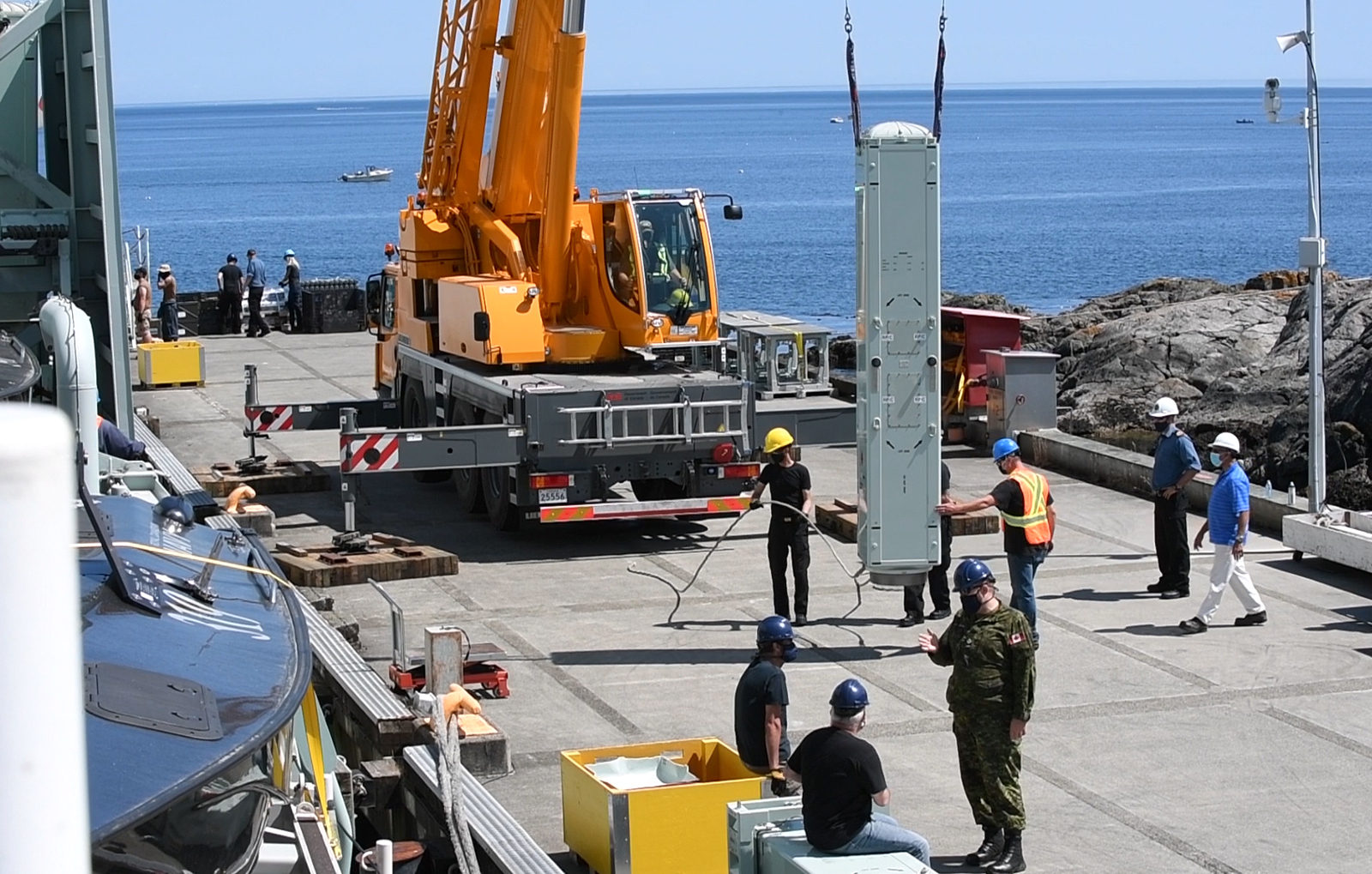An evolution unlike any other: Transferring ESSMs in the time of COVID-19
By Lookout on Dec 02, 2020 with Comments 0
Captain Chelsea Dubeau
HMCS Winnipeg PAO
––
The morning of Aug. 31 was a hot one in Pearl Harbor. The Combat Systems Engineering Officer aboard HMCS Winnipeg stood on the flight deck, ready to give a safety brief. Another successful Rim of the Pacific (RIMPAC) exercise had just wrapped, where Winnipeg’s Combat Systems Engineering (CSE) department figured quite significantly in the many gunnery exercises that took place.
For Lieutenant (Navy) Julien St-Aubin, the coming CSE evolution had been months in the making and it was not like any other he had done. In fact, on that day his team did something that hadn’t been done in many years: led the evolution of transferring two empty Evolved Sea Sparrow Missile (ESSM) canisters and one spare Telemetric ESSM from Winnipeg, and embarked three Warshot ESSM from HMCS Regina. The ammunition transfer was part of Winnipeg’s preparations in advance of its deployment on Operation Projection-Neon.
Ammunition safety protocols in normal times
Ammunition safety protocols, including the regulation of procurement, storage, transportation, inspection, maintenance, authorized modification, issue, use, and disposal of all ammunition and explosives with the Department of National Defence and the Canadian Armed Forces are managed through the Director Ammunition and Explosives Regulation (DAER). What this means is that under normal circumstances Winnipeg’s CSE team would only play a supporting role to the subject matter experts identified by DAER, who would be on-site in Pearl Harbor and led the transfer, comprised primarily of Canadian Forces Ammunition Depot (CFAD) Rocky Point staff.
“The Royal Canadian Navy’s ship staff members haven’t been in command of this type of evolution for decades,” said Lt(N) St-Aubin.
COVID-19 times, a little different
But the circumstances at play were anything but normal.
Due to COVID-19 restrictions, flying CFAD staff out to Hawaii to oversee the missile re-arm, as is typical, was impossible.
“As the Pacific Fleet was directed to honour our commitment to participate in RIMPAC during a global pandemic, knowing most if not all auxiliary support would become a struggle, ship’s staff were asked to conduct staff checks in order to support the potential missions mandated to Winnipeg,” said Lt(N) St-Aubin. “This prompted me to liaise with both the CSEO of HMCS Regina and CFAD staff to find out if Winnipeg’s ship’s staff could potentially load missiles ourselves.
“CFAD staff provided a lot of additional training and mentorship to both myself and my Fire Control Technicians; from understanding the composition of the ESSM canisters – including areas of concerns such as hard points for transport and inspection of the various connections – to key observations for the installation onboard HMC ships, which are crucial for system operability.”
CFAD staff walked Winnipeg’s CSE team members through several missile embarkations until they were ready to setup, crane aboard, and install several ESSM canisters themselves.
“CFAD staff wanted to ensure that not only did we install the canisters correctly by following their meticulous procedures, but also that we did it with safety in mind. There are many moving parts and personnel involved in the manipulation of the canisters themselves,” said Lt(N) St-Aubin.
The safety brief was delivered and Lt(N) St-Aubin’s team set to work as the three canisters were first craned off of Winnipeg. It was meticulous and intensely focused work, and once Winnipeg’s canisters were off and secured for transport, the team moved over to Regina’s jetty, just a short RHIB ride away. Time to get the Warshot ESSMs.
Helping to oversee the evolution was Chief Petty Officer Second Class (CPO2) Nels Jensen, a member of Sea Training Pacific who had been on board Winnipeg since the ship departed Aug. 1. Winnipeg’s Intermediate Multi-Ship Readiness Training (IMSRT) program had been overlaid with RIMPAC, but on that day CPO2 Jensen wasn’t there to evaluate a sea training exercise.
“In terms of this specific evolution, we’re representing the Formation Ammunition Inspector to make sure that the ship is operating in accordance with safety and policy,” said CPO2 Jensen. “So it’s less about the sea training piece, and more about the safety piece.”
The Warshot ESSMs were successfully craned off Regina; back at Winnipeg, they were craned on board. The transfer was complete.
Will this evolution be repeated
Even though this was a temporary capability, its training value cannot be underestimated.
“Our ability to do these things and adapt, like being able to transfer ESSM without the support of other units, is a good example of how our technicians can quickly learn a skill and then put it into place and make it happen safely,” said CPO2 Jensen.
Will this evolution be repeated? It will depend on COVID-19 mitigation measures in the future.
“We might have to do this again,” said CPO2 Jensen. “And Winnipeg’s CSE team will have expertise to lend support to another ship that may have to do it.”
Throughout the evolution, from the planning right up to the execution, there were hurdles to be jumped and obstacles to overcome.
“We are constantly challenged with new problems to solve,” said Lt(N) St-Aubin. “Understanding the task and the desired end state is key, while always ensuring that safety is maintained. We’ve had to be adaptive and flexible.”
Winnipeg is deployed to the Asia-Pacific region on Operation Projection to conduct forward naval presence operations from September to December 2020. While deployed in the region, Winnipeg will also operate under Operation Neon, Canada’s contribution to a coordinated multinational effort to support the implementation of United Nations Security Council sanctions imposed against North Korea.
––––
Filed Under: Top Stories
About the Author:






